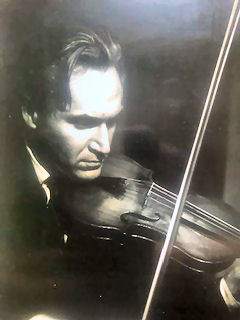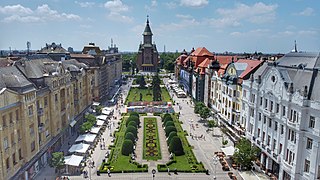
Bucharest is the capital and largest city of Romania. The metropolis stands on the River Dâmbovița in south-eastern Romania. Its population is officially estimated at 1.76 million residents within a greater metropolitan area of 2.3 million residents, which makes Bucharest the 8th most-populous city in the European Union. The city area measures 240 km2 and comprises 6 districts (Sectoare), while the metropolitan area covers 1,811 km2. Bucharest is a beta global city, a major cultural, political and economic hub, and the country's seat of government.

Tarja Soile Susanna Turunen-Cabuli, known professionally as Tarja Turunen or simply Tarja, is a Finnish heavy metal singer, best known as the former lead vocalist of Nightwish.

The Royal Palace of Bucharest, known as Palace of the Republic between 1948 and 1990, is a monumental building situated in the capital of Romania, on Calea Victoriei. The palace in its various incarnations served as official residence for the kings of Romania until 1947, when the communist regime was installed after Michael I of Romania's forced abdication. Since 1950, the palace hosts the National Museum of Art of Romania. The Romanian royal family currently uses Elisabeta Palace as its official residence in Bucharest. In addition, the Romanian government allows the royal family to use the Royal Palace different occasions.

The National Theatre Bucharest is one of the national theatres of Romania, located in the capital city of Bucharest.

Tudor Gheorghe is a Romanian musician, actor, and poet known primarily for his politically charged musical career and his collaborations with well-known figures of late 20th-century Romanian poetry. His recording work is sometimes associated with anti communist activism and has received much critical acclaim over the years. The son of an Iron Guard member, he was banned from performing and recording in 1987 after a concert at Sala Palatului in Bucharest, following a number of run-ins with Romania's communist authorities throughout the 1970s and 1980s.

Bulevardul Magheru is a major street in central Bucharest. Built in the early 20th century, it is named after General Gheorghe Magheru.

Carol I Park is a public park in Bucharest, Romania, named after King Carol I of Romania. A French garden located in the southern-central area of Bucharest, partly on Filaret Hill, originally capable of hosting various exhibitions, it suffered considerable modifications during the communist regime, including a name change to Parcul Libertății.
Revolution Square is a square in central Bucharest, on Calea Victoriei. Known as Palace Square until 1989, it was renamed after the Romanian Revolution of December 1989. The former Royal Palace, the Athenaeum, the Athénée Palace Hotel, the University of Bucharest Library and the Memorial of Rebirth are located here. The square also houses the building of the former Central Committee of the Romanian Communist Party. In 1990, the building became the seat of the Senate and since 2006 it houses the Ministry of Interior and Administrative Reform.

Grădina Icoanei is a small park in central Bucharest, situated not far away from Piața Romană and Bulevardul Magheru. The park, located next to Gheorghe Cantacuzino Plaza in Sector 2 of the city, was inaugurated in 1873.

The MTV Romania Music Awards have been held since 2002 celebrating Romanian music. Recipients of the awards have been Eurovision contestants and some have gone on to represent Romania in the competition. The awards were usually held in June. Since 2008 the show was cancelled. Starting then, it was replaced by the Romanian Music Awards, organized by Music Channel Romania.
Romanian architecture is very diverse, including medieval, pre-World War I, interwar, postwar, and contemporary 21st century architecture. In Romania, there are also regional differences with regard to architectural styles. Architecture, as the rest of the arts, was highly influenced by the socio-economic context and by the historical situation. For example, during the reign of King Carol I (1866–1914), Romania was in a continuous state of reorganization and modernization. In consequence, most of the architecture was designed by architects trained in Western European academies, particularly the École des Beaux-Arts, and a big part of the downtowns of the Romanian Old Kingdom were built during this period.

Mihail Fărcășanu was a Romanian journalist, diplomat and writer. He was president of the National Liberal Youth from 1937 to 1946. Pursued by the authorities due to his anti-communist actions, he managed to flee the country in 1946, and was later sentenced to death.

Elena Gheorghe is a Romanian singer. In the first half of the 2000s, she joined the Romanian pop group Mandinga, with whom she released two albums. In 2006, she separated from the group and pursued her solo career. She has released three studio albums and one compilation album. She scored a top ten in the Romanian Top 100 with the debut single "Vocea Ta".
Piața Constituției is one of the largest squares in the centre of Bucharest, Romania. The square is standing face-to-face with the Palace of the Parliament and it is bisected by Bulevardul Unirii and by Bulevardul Libertății.

The Bucharest Symphony Orchestra is a Romanian orchestra based in Bucharest, founded in 2006 by the Philson Young Association. In 2022, John Axelrod was appointed Principal Conductor of the Bucharest Symphony Orchestra. Previously, Jin Wang (2017–2019) and Benoît Fromanger occupied the leading musical position (2011–2017). Between 2006–2012, Bucharest Symphony Orchestra performed in concert halls such as the Romanian Athenaeum, National Theatre Bucharest, Romanian National Opera and Sala Palatului.

There were numerous protests against the Romanian Government between 2017 and 2019. In January 2017, days after the government of the Grindeanu Cabinet was sworn into office in Romania, protests took place throughout the country against ordinance bills that were proposed by the Romanian Ministry of Justice regarding the pardoning of certain committed crimes, and the amendment of the Penal Code of Romania. At the heart of these protests is the community Corruption Kills, founded by Florin Bădiță, who alongside other civic groups organized what proved to be the largest protests since 1989, thus realizing the "Revolution of our generation".

The Victory Square, known until 1990 as the Opera Square, is the central square of Timișoara. It is the place where Timișoara was proclaimed on 20 December 1989 the first city free of communism in Romania. It was a main boulevard, transformed into a square after the closure of the southern side by the construction of the Metropolitan Cathedral. The opposite poles of the square consist of the Opera to the north and the Metropolitan Cathedral to the south. From the Opera to the Cathedral the promenade on the right is called Corso, and the one on the left is called Surogat. Both have protected architectural ensembles of local historical importance.

St. George Square is a small urban square in the historic center of Timișoara. The place was known in the past as Seminary Square; there was first a Catholic church, which later became a mosque during the Ottoman occupation, and after the installation of the Austrian administration the building was handed over to the Jesuits who opened a new church, dedicated to St. George. Surrounded by imposing buildings, the square has long been the spiritual, financial and cultural center of the fortress of Timișoara.

Romanian Revival architecture is an architectural style that has appeared in the late 19th century in Romanian Art Nouveau, initially being the result of the attempts of finding a specific Romanian architectural style. The attempts are mainly due to the architects Ion Mincu (1852–1912), and Ion N. Socolescu (1856–1924). The peak of the style was the interwar period. The style was a national reaction after the domination of French-inspired Classicist Eclecticism. Apart from foreign influences, the contribution of Romanian architects, who reinvented the tradition, creating, at the same time, an original style, is manifesting more and more strongly. Ion Mincu and his successors, Grigore Cerchez, Cristofi Cerchez, Petre Antonescu, or Nicolae Ghica-Budești declared themselves for a modern architecture, with Romanian specific, based on theses such as those formulated by Alexandru Odobescu around 1870:
"Study the remains – no matter how small – of the artistic production of the past and make them the source of a great art (...) do not miss any opportunity to use the artistic elements presented by the Romanian monuments left over from old times; but transform them, change them, develop them ..."
The 2021–22 season was Dinamo București's 73rd year in their history, all of them played in the top-flight of Romanian football. Along with the league, the club also competed in the Cupa României. The season covered the period from 15 June 2021 to 1 June 2022.

















